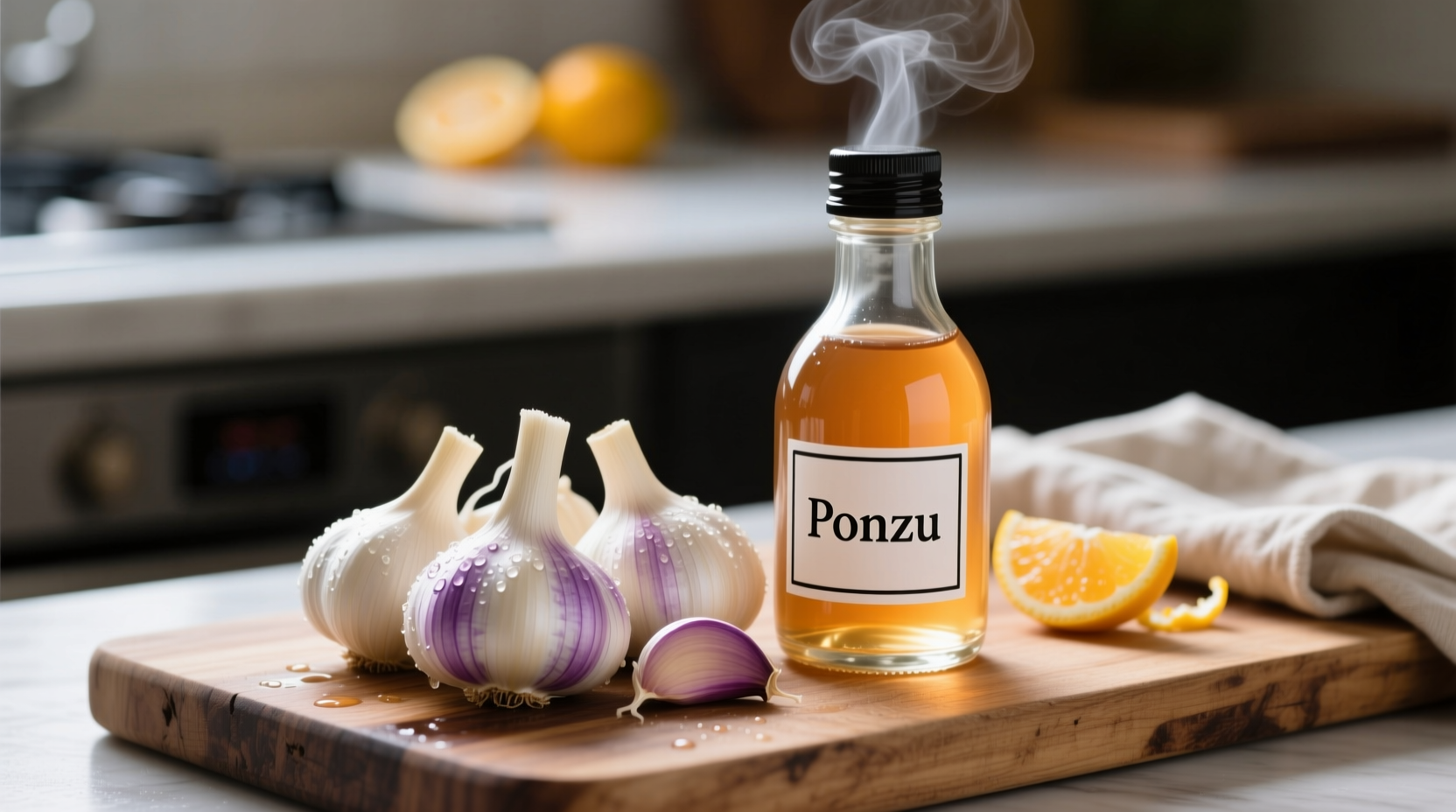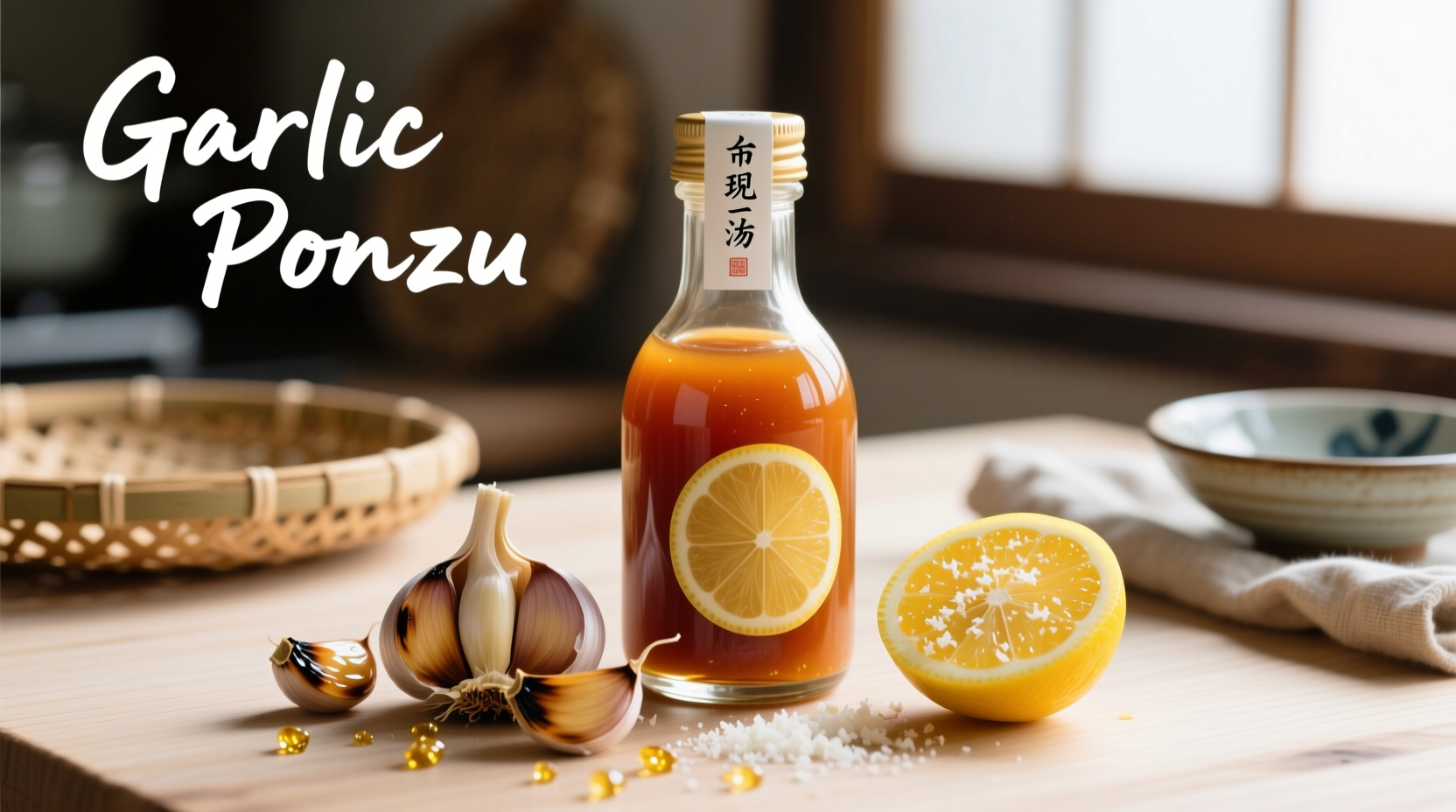Discover how this simple yet sophisticated sauce can transform your everyday cooking. Whether you're a home chef looking to expand your flavor repertoire or a culinary enthusiast seeking authentic Japanese-inspired ingredients, understanding garlic ponzu's unique properties will help you create restaurant-quality dishes with minimal effort.
What Exactly Is Garlic Ponzu and Why Chefs Rely On It
Garlic ponzu represents a modern evolution of traditional ponzu, Japan's beloved citrus-soy dipping sauce. While classic ponzu features citrus juice (typically yuzu, lemon, or lime) blended with soy sauce, mirin, and katsuobushi (dried bonito flakes), garlic ponzu incorporates fresh or roasted garlic to add aromatic complexity and depth.
Unlike Western garlic sauces that often rely on olive oil bases, garlic ponzu maintains the light, refreshing quality of its citrus foundation while delivering garlic's signature pungency. This balance makes it particularly valuable for dishes where heavy garlic preparations would overwhelm delicate ingredients.
| Characteristic | Traditional Ponzu | Garlic Ponzu |
|---|---|---|
| Primary Flavor Profile | Citrus-forward with subtle umami | Garlic-enhanced citrus-umami balance |
| Garlic Content | None | 1-3% fresh or roasted garlic |
| Best Applications | Sashimi, delicate fish, steamed vegetables | Grilled meats, heartier fish, roasted vegetables |
| Shelf Life (unopened) | 12-18 months | 9-12 months (garlic accelerates oxidation) |
How Garlic Transforms Traditional Ponzu: A Flavor Evolution
Ponzu's history traces back to Japan's Edo period (1603-1868), when Dutch traders introduced citrus fruits to Japanese cuisine. The name "ponzu" derives from the Dutch word "pons" (meaning punch or citrus beverage). Traditional ponzu remained relatively unchanged for centuries until global flavor fusion inspired modern variations.
The incorporation of garlic represents a significant evolution in ponzu's development:
- 1980s: Japanese chefs in Hawaii began experimenting with local ingredients, adding garlic to ponzu for poke bowls
- 1990s: California fusion cuisine popularized garlic ponzu as a versatile sauce for grilled fish
- 2000s: Mainstream adoption as premium grocery stores began carrying commercial versions
- Present: Garlic ponzu has become a staple in professional kitchens worldwide, with chefs creating signature variations using different garlic preparations

When Garlic Ponzu Shines: Practical Applications and Limitations
Understanding where garlic ponzu excels—and where it might not work—is crucial for maximizing its culinary potential. This context awareness separates thoughtful cooking from haphazard sauce application.
Ideal Applications
- Grilled proteins: Perfect for skirt steak, chicken thighs, and salmon where garlic complements charred flavors
- Roasted vegetables: Elevates Brussels sprouts, asparagus, and mushrooms with its balanced acidity
- Marinades: The acid in citrus helps tenderize while garlic penetrates proteins
- Dipping sauce: Excellent with gyoza, tempura, and spring rolls for added complexity
Contextual Limitations
Garlic ponzu isn't universally applicable. Consider these limitations when planning your dishes:
- Delicate seafood: Can overwhelm subtle flavors in sashimi-grade tuna or flounder
- Dairy-based dishes: Clashes with creamy textures in pasta or sauces
- Sweet applications: Doesn't complement dessert profiles or fruit-based dishes
- Extended cooking: Garlic flavor diminishes with prolonged heat exposure
Crafting Perfect Garlic Ponzu: A Chef's Approach
While quality commercial options exist (look for brands like Yamasa or Mitsukan), making your own garlic ponzu allows customization of flavor intensity. Professional chefs typically use one of three garlic preparation methods, each yielding distinct results:
- Raw garlic infusion: Finely minced garlic steeped in ponzu for 24-48 hours (bright, sharp garlic notes)
- Roasted garlic blend: Whole roasted garlic cloves blended into ponzu (mellow, sweet garlic profile)
- Garlic oil integration: Garlic-infused oil whisked into ponzu (smooth texture, consistent flavor)
For home preparation, try this professional technique that maximizes flavor extraction while maintaining balance:
- Combine 1 cup优质 ponzu sauce (check for authentic ingredients) with 2 finely minced garlic cloves
- Add 1 teaspoon toasted sesame oil for depth (optional)
- Let mixture rest at room temperature for 2 hours to allow flavors to meld
- Refrigerate for 24 hours before use for optimal flavor integration
- Store in airtight container for up to 2 weeks (garlic flavor intensifies over time)
Shopping Smart: Selecting Quality Garlic Ponzu
Not all garlic ponzu sauces deliver authentic flavor. When selecting a commercial product, look for these markers of quality:
- Ingredient transparency: Should list specific citrus types (yuzu, sudachi, or kabosu) rather than generic "citrus juice"
- Garlic form: "Fresh garlic" or "garlic extract" indicates better quality than "garlic powder"
- No artificial additives: Avoid products with MSG, artificial colors, or preservatives like sodium benzoate
- Balance indicators: Should contain rice vinegar or mirin for proper acid-sweet balance
According to the U.S. Food and Drug Administration's food labeling guidelines, authentic ponzu must contain at least 5% citrus juice by volume. Quality garlic ponzu maintains this standard while incorporating 1-3% garlic content.
Creative Culinary Applications Beyond the Expected
Move beyond basic dipping sauce applications with these professional chef techniques that leverage garlic ponzu's unique properties:
- Salad dressing base: Whisk with equal parts neutral oil for vibrant Asian-inspired vinaigrettes
- Stir-fry finish: Add in the last minute of cooking for bright flavor without raw garlic harshness
- Grain enhancement: Toss with cooked rice or quinoa for instant flavor complexity
- Mayo transformation: Mix 1:1 with mayonnaise for gourmet sandwich spread
- Cocktail component: Add to Bloody Mary mix for umami depth (2-3 teaspoons per serving)
Japanese culinary experts at the Japan External Trade Organization note that garlic ponzu's versatility stems from its balanced pH level (approximately 4.2), which makes it equally effective as both a marinade and finishing sauce without causing protein denaturation like stronger acids.
Troubleshooting Common Garlic Ponzu Challenges
Even experienced cooks encounter issues with garlic-based sauces. Here's how to address common problems:
- Overpowering garlic flavor: Dilute with additional ponzu or a splash of rice vinegar
- Separated ingredients: Whisk vigorously or blend briefly to re-emulsify
- Bitter notes: Add 1/4 teaspoon honey to balance excessive garlic pungency
- Loss of brightness: Stir in fresh citrus zest to revive flavor profile











 浙公网安备
33010002000092号
浙公网安备
33010002000092号 浙B2-20120091-4
浙B2-20120091-4